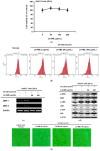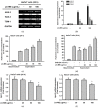In Vitro Anti-Photoaging and Skin Protective Effects of Licania macrocarpa Cuatrec Methanol Extract
- PMID: 35631808
- PMCID: PMC9144732
- DOI: 10.3390/plants11101383
In Vitro Anti-Photoaging and Skin Protective Effects of Licania macrocarpa Cuatrec Methanol Extract
Abstract
The Licania genus has been used in the treatment of dysentery, diabetes, inflammation, and diarrhea in South America. Of these plants, the strong anti-inflammatory activity of Licania macrocarpa Cuatrec (Chrysobalanaceae) has been reported previously. However, the beneficial activities of this plant on skin health have remained unclear. This study explores the protective activity of a methanol extract (50-100 μg/mL) in the aerial parts of L. macrocarpa Cuatrec (Lm-ME) and its mechanism, in terms of its moisturizing/hydration factors, skin wrinkles, UV radiation-induced cell damage, and radical generation (using RT/real-time PCR, carbazole assays, flowcytometry, DPPH/ABTS, and immunoblotting analysis). The anti-pigmentation role of Lm-ME was also tested by measuring levels of melanin, melanogenesis-related genes, and pigmentation-regulatory proteins. Lm-ME decreased UVB-irradiated death in HaCaT cells by suppressing apoptosis and inhibited matrix metalloproteinases 1/2 (MMP1/2) expression by enhancing the activity of extracellular signal-regulated kinase (ERK), c-Jun N-terminal kinase (JNK), and p38. It was confirmed that Lm-ME displayed strong antioxidative activity. Lm-ME upregulated the expression of hyaluronan synthases-2/3 (HAS-2/3) and transglutaminase-1 (TGM-1), as well as secreted levels of hyaluronic acid (HA) via p38 and JNK activation. This extract also significantly inhibited the production of hyaluronidase (Hyal)-1, -2, and -4. Lm-ME reduced the melanin expression of microphthalmia-associated transcription factor (MITF), tyrosinase, and tyrosinase-related protein-1/2 (TYRP-1/2) in α-melanocyte-stimulating hormone (α-MSH)-treated B16F10 cells via the reduction of cAMP response element-binding protein (CREB) and p38 activation. These results suggest that Lm-ME plays a role in skin protection through antioxidative, moisturizing, cytoprotective, and skin-lightening properties, and may become a new and promising cosmetic product beneficial for the skin.
Keywords: B16 melanoma cells; HaCaT cells; UVB exposure; melanogenesis; wrinkle formation.
Conflict of interest statement
The authors declare no conflict of interest.
Figures








Similar articles
-
Anti-Wrinkling and Anti-Melanogenic Effect of Pradosia mutisii Methanol Extract.Int J Mol Sci. 2019 Feb 27;20(5):1043. doi: 10.3390/ijms20051043. Int J Mol Sci. 2019. PMID: 30818884 Free PMC article.
-
Anti-Inflammatory Effects of Licania macrocarpa Cuatrec Methanol Extract Target Src- and TAK1-Mediated Pathways.Evid Based Complement Alternat Med. 2019 Sep 12;2019:4873870. doi: 10.1155/2019/4873870. eCollection 2019. Evid Based Complement Alternat Med. 2019. PMID: 31611922 Free PMC article.
-
Skin protective effect of Indian gooseberry and barley sprout complex on skin dryness, wrinkles, and melanogenesis by cell models.Nutr Res Pract. 2024 Oct;18(5):587-601. doi: 10.4162/nrp.2024.18.5.587. Epub 2024 Jun 13. Nutr Res Pract. 2024. PMID: 39398880 Free PMC article.
-
Artemisia asiatica ethanol extract exhibits anti-photoaging activity.J Ethnopharmacol. 2018 Jun 28;220:57-66. doi: 10.1016/j.jep.2018.03.037. Epub 2018 Mar 31. J Ethnopharmacol. 2018. PMID: 29609010
-
Photoaging Protective Effects of Ranunculus bulumei Methanol Extract.Evid Based Complement Alternat Med. 2020 Apr 3;2020:1761785. doi: 10.1155/2020/1761785. eCollection 2020. Evid Based Complement Alternat Med. 2020. PMID: 32328122 Free PMC article.
Cited by
-
The Potential of Purple Waxy Corn Cob (Zea mays L.) Extract Loaded-Sericin Hydrogel for Anti-Hyperpigmentation, UV Protection and Anti-Aging Properties as Topical Product Applications.Pharmaceuticals (Basel). 2022 Dec 27;16(1):35. doi: 10.3390/ph16010035. Pharmaceuticals (Basel). 2022. PMID: 36678532 Free PMC article.
-
A Comprehensive Quality Analysis of Different Colors of Medicinal and Edible Honeysuckle.Foods. 2023 Aug 20;12(16):3126. doi: 10.3390/foods12163126. Foods. 2023. PMID: 37628125 Free PMC article.
-
Protective Function of Malus baccata (L.) Borkh Methanol Extract against UVB/Hydrogen Peroxide-Induced Skin Aging via Inhibition of MAPK and NF-κB Signaling.Plants (Basel). 2022 Sep 11;11(18):2368. doi: 10.3390/plants11182368. Plants (Basel). 2022. PMID: 36145769 Free PMC article.
-
Antiphotoaging and Skin-Protective Activities of Ardisia silvestris Ethanol Extract in Human Keratinocytes.Plants (Basel). 2023 Mar 3;12(5):1167. doi: 10.3390/plants12051167. Plants (Basel). 2023. PMID: 36904025 Free PMC article.
-
Anti-Oxidative and Anti-Aging Effects of Ethanol Extract of the Officinal Breynia (Breynia vitis-idaea) In Vitro.Plants (Basel). 2023 Mar 1;12(5):1088. doi: 10.3390/plants12051088. Plants (Basel). 2023. PMID: 36903948 Free PMC article.
References
-
- Saba E., Kim S.H., Lee Y.Y., Park C.K., Oh J.W., Kim T.H., Kim H.K., Roh S.S., Rhee M.H. Korean red ginseng extract ameliorates melanogenesis in humans and induces antiphotoaging effects in ultraviolet B-irradiated hairless mice. J. Ginseng Res. 2020;44:496–505. doi: 10.1016/j.jgr.2019.05.003. - DOI - PMC - PubMed
Grants and funding
LinkOut - more resources
Full Text Sources
Research Materials
Miscellaneous

